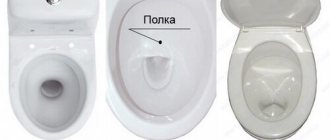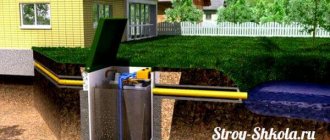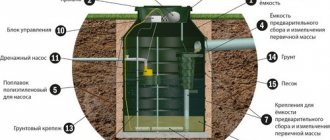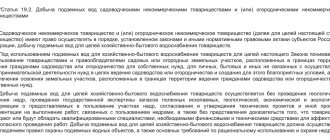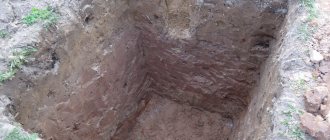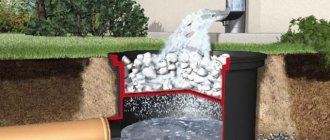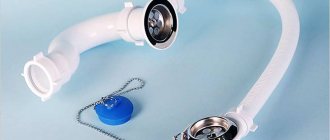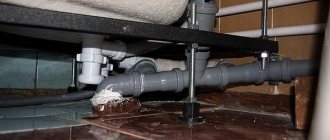Today it is impossible to imagine convenience and complete comfort in a private house or country house without an autonomous sewage system.
This is an integral part of achieving the most comfortable conditions that are inherent in apartments.
Therefore, most people strive to install a sewer system with their own hands as soon as possible and enjoy all the delights of life in the private sector.
As a rule, an autonomous sewerage system is laid on a site during the construction of a house, even when laying the foundation.
But if you already have a house, then you can easily install a sewer system only if you meet certain requirements.
Autonomous sewage system in the house
Of course, one of the main questions that arises is which septic tank is best to install.
It is known that there are two options - an anaerobic septic tank and an aerobic installation for treating domestic wastewater.
These are two different devices, each with its own advantages and disadvantages.
And yet, the more popular installation is the anaerobic septic tank.
Why this is so will be clear from the contents of the article.
Let's take a closer look at the anaerobic septic tank, what it is and how it functions.
Aerobic septic tank
What is an anaerobic septic tank, what materials are the installations made from?
An anaerobic septic tank is a sealed container in which microbiological decomposition of organic substances occurs without a special supply of air oxygen.
That is, microorganisms perform the main function of wastewater purification without adding oxygen.
All the necessary conditions are created in the container for the reproduction of a number of bacteria; the result of their vital activity is methane, ammonia, and hydrogen sulfide.
Anaerobes must perform their main function, namely: ensure the decomposition of complex components into simple ones.
If there is an insufficient number of microorganisms in the septic tank, then their number is increased artificially by introducing special preparations into the sewage system.
This is what an anaerobic septic tank looks like, its structure
By design, such septic tanks can be single-chamber, or they can consist of several structures.
It is worth saying that two-chamber installations are considered the most popular, where the main suspensions are settled in one chamber, and in the other the wastewater is additionally treated with anaerobes and clarified.
During the process of biological treatment, the temperature of the wastewater increases, which creates excellent conditions for microorganisms even in the cold season.
Everything that microorganisms secrete during their life activity is perfectly eliminated through the ventilation system of the septic tank.
Anaerobic septic tank for home
If we talk about the materials used for the manufacture of installations, then modern manufacturers for the most part rely on plastic elements.
This is due to their clear advantage over other materials.
The most popular are installations made of polypropylene and other types of polymer compounds.
These containers are very strong, reliable, resistant to aggressive environments and durable.
It is known that plastic can last up to 50 years, which cannot be said about other building materials for septic tanks.
You can make a septic tank from Eurocubes and reinforced concrete rings, but these materials are of lower quality and durable.
And installation of an installation made from such materials is more labor-intensive and requires more costs and time. And yet it’s up to you to choose.
PVC anaerobic septic tank
Choosing the best option
Before choosing the best septic model, you must:
- Make an estimate of the average daily volume of wastewater , which depends on the number of residents and the availability of sanitary equipment.
- Make an assessment of the soil composition and the level of location of underground sources to determine the possibility and feasibility of constructing filtration fields.
- Determine the purpose of housing - permanent or periodic.
- Calculation of funds for the installation of a sewerage system on the site.
Volume
According to sanitary rules, wastewater treatment equipment must freely accommodate the volume generated within 3 days, which will be affected by the number of people living in a private building. On average, 1 individual consumes 200 liters per day.
A calculation is made of water consumption for all residents for 3 days. Since the volume of a septic device is calculated in cubic meters, then 1 unit = 1000 liters. Devices with a volume of up to 1 cubic meter come standard with 1 compartment, sufficient for complete disinfection of wastewater; for volumes above 10 cubic meters, it is necessary to choose tanks with 3 sections.
Device material
- Plastic – characterized by lightness, durability and easy installation without the use of special equipment. The average service life is several decades. A peculiarity of the arrangement of a plastic structure is the need to anchor it or concrete it in order to avoid the floating of part of the tank. The choice will be affected by the thickness of the walls, the presence of stiffeners and the type of plastic.
- Concrete - characterized by simplicity, durability, strength, non-corrosion and heavy weight. Such a septic tank is installed in 2 ways: using ready-made concrete rings installed using special equipment, and pouring the concrete mixture into the assembled formwork and constructing the structure in stages.
- Metal ones are characterized by relative lightness, easy installation and affordable price. The downside is susceptibility to corrosion, and accordingly, a reduced service life.
Priming
Modern designs are equipped with an additional purification device - filtration fields. But to perform this cleaning procedure, there must be appropriate conditions at the site. Since, for example, clay soils have poor water permeability, which prevents the filtration of treated wastewater. Additionally, with high occurrence of underground sources, the construction of effective filtration fields becomes more complicated.
Therefore, the construction of a purification system with a filtration field is possible if suitable soil is available. The possibility of arranging soil filtration on clay soils will require the removal of part of the soil and replacement with a crushed stone-sand mixture. And this will increase the cost of installing a sewer system. It would be more rational to install a septic tank with a biofilter that carries out all stages of purification without additional output filtration.
Expenses
The most expensive device is the cleaning device, but it is the most economical to use, since correctly installed components will require a rare call to the vacuum cleaner. However, the choice of a septic tank depends on the conditions of its use. With good insulation, it is advisable to prefer an aerobic septic tank, whose price category starts from 60,000 rubles.
When studying the filtration system in a tank, the most popular are devices with a deep purification bioelement, whose capabilities allow you to filter wastewater by 98%. In this case, there is practically no need to call a vacuum cleaner; its price category is 500,000-600,000 rubles.
The price is also affected by the material of the cleaning container. If the tank is made of stainless steel, its price is 120,000-150,000 rubles, which is expensive, but its unpopular choice is explained by its susceptibility to corrosion due to exposure to aggressive substances, which can cause its rapid breakdown.
A concrete tank requires a lot of money and time, since its production can be done in two ways. The simplest: installing concrete rings using special equipment. Another way: performing formwork and pouring concrete in stages. The price will depend on the cost of the building materials used and the hiring of special equipment.
A plastic septic tank costs from 50,000 rubles and is light in weight, which allows you to install it yourself in a short period of time.
Another selection parameter is the performance of the treatment device, its ability to process certain volumes of wastewater. The volume of chambers and their number will be affected by water consumption.
For occasional residence, you should prefer the simplest and cheapest septic tank - a storage one, with a reservoir for collecting and storing wastewater. When it is full, it will require regular cleaning with a vacuum cleaner. For permanent residence, a storage septic tank is inconvenient due to the need for frequent cleaning of the tank. The solution is to purchase an overflow device with the ability to accumulate and purify wastewater.
If there is a large volume of wastewater due to the construction of a swimming pool or bathhouse, the option of a septic tank with aeration is optimal. The presence of an aerator is necessary to create conditions for the vital activity of bacteria, which contribute to the effective treatment of wastewater and increase the productivity of the device.
Main advantages and disadvantages
A do-it-yourself anaerobic septic tank for a private home has both advantages and disadvantages.
As for the advantages:
DIY anaerobic septic tank
- system autonomy;
- avoiding contact with untreated wastewater;
- absence of unpleasant odors;
- ease of installation;
- affordable price.
Do-it-yourself anaerobic septic tank for your home
Regarding the disadvantages, such installations require the creation of additional ground treatment, that is, after the work of anaerobes, the wastewater must undergo filtration, only after which it can be used for technical purposes, for example, for watering a garden.
Contact us
If you have a house in MSC or a cottage in Mo without an autonomous sewer system, contact us. We will help you choose the best system option, deliver equipment and materials, and quickly carry out installation work. If you already have a sewerage system, but you are not satisfied with its functionality, you can buy an aerator for a septic tank and a compressor and order their installation from us. If necessary, we will provide advice on the type of aerator and compressor power.
- SEPTIC FOR 10 PEOPLE
- SEPTIC FOR SHOWER
Don't know which septic tank is right for you? Get a free consultation right now!
| Request a call | Call us at +7 (499) 112-40-28 | Write to us by email: [email protected] |
Service
An anaerobic septic tank requires minimal maintenance, in particular, you need to regularly pump out sludge from the bottom of the septic tank once a year. As a rule, such work is carried out by organizations with a special machine, the volume of which allows for pumping out a sufficient amount of sediment and wastewater. A pipe is placed in the sewer well through which wastewater is sucked into the machine. Of course, you can clean the septic tank yourself and use the sediment extracted from it as fertilizer. But for this it is necessary to pre-dry the sludge. Only after it stops flowing from the shovel can it be used for gardening purposes.
Cleaning an anaerobic septic tank with a sewer
User reviews
We have Topas, which suits us in almost everything, but it is energy dependent and during a power outage, the use of a septic tank is prohibited and this equipment should not be left for more than 2 hours. At a new dacha, I prefer to install a Tank, which is non-volatile and much cheaper than Topas. When installing Topas, it is advisable to prefer models with forced ejection. For example, due to constant power outages, we purchased a generator. If Topas is not used, you will need to call specialists to temporarily freeze it. In addition, the use of preparations containing chlorine is not permitted. Sergey, Voronezh
Topas has been working for us for 7 years and constantly serves 3 people. Restrictions – avoidance of chemicals with chlorine, use only cellulose paper, pouring out mushroom decoctions is prohibited. This, in principle, applies to both aerobic and anaerobic purification devices. I like the Topas, but it requires maintenance once every 3 months, which requires certain skills and abilities. Volodya, Penza
I bought the Tank 2.5 installation and regretted it. The device was crushed and cracks appeared on its bottom along the length of the ribs due to the thickness of the case 3-5 mm. The device is poorly made. In the presence of sandy soil and a water depth of 1 m, the mounted device was filled 50% with water and backfilled. As a result, it required repeated dismantling, body repairs, installation back with the enclosing frame and uncertainty about its complete tightness. Ilya, Krasnodar
Difference between anaerobes and aerobes
The main difference between aerobes and anaerobes is that the former are able to live and reproduce in conditions with high oxygen content. Therefore, such septic tanks must be equipped with a compressor and an aerator for pumping air. Typically, these on-site treatment plants do not emit such an unpleasant odor.
In contrast, anaerobic representatives (as the microbiology table described above shows) do not require oxygen. Moreover, some of their species can die with a high content of this substance. Therefore, such septic tanks do not require pumping air
For them, it is only important to remove the generated methane
Another difference is the amount of sediment formed. In aerobic systems, the amount of sediment is much less, so the structure can be cleaned much less frequently. In addition, the septic tank can be cleaned without calling a vacuum cleaner. To remove thick sediment from the first chamber, you can take a regular net, and to pump out the activated sludge formed in the last chamber, it is enough to use a drainage pump. Moreover, activated sludge from a treatment plant using aerobes can be used to fertilize the soil.
https://youtube.com/watch?v=vdyNCQ1S3F4
Installation of the structure
Do-it-yourself installation of a treatment plant is carried out in the following sequence:
- They start with excavation work and dig a trench to lay the supply pipe. The pipeline must be laid below the soil freezing mark.
- The bottom of the trench is filled with sand and compacted. At the same time, do not forget about maintaining the slope.
- Now you can dig a pit for the septic tank. The dimensions of the pit should be made 50 cm larger on each side than the size of the septic tank structure.
- The bottom of the pit is also filled with sand and compacted.
- To increase strength, the bottom is concreted and reinforced (layer height 100 mm). If a plastic septic tank is used, then it is worthwhile to provide fitting outlets in the form of eyelets. A septic tank will then be attached to them to protect them from floating.
- After this, you can proceed to installing or constructing a tank from the selected material. The installation sequence depends on the material used. After installation, the joints of the concrete rings are coated with a mixture of liquid glass and cement, and then fastened with staples. Then holes are made for the pipeline and overflow. After connecting the pipes, the holes are sealed. The outside of the container is wrapped with roofing felt, and the ceiling and hatch are installed. A monolithic concrete septic tank is made using formwork and reinforcement. The holes between the chambers should be provided in advance so as not to drill them later. You need to make holes in the plastic tank for pipes, ventilation, aeration and overflows. This container, after being installed on a concrete base, is additionally fixed by the eyes in it.
How do anaerobes get energy?
Anaerobic organisms can obtain energy in different ways:
- Some microorganisms obtain energy through the catabolism of various amino acid compounds, such as proteins and peptides, as well as the amino acids themselves. Typically, this process of releasing energy is called putrefaction. And the environment itself, in the energy exchange of which many processes of catabolism of amino acid compounds and amino acids themselves are observed, is called a putrefactive environment.
- Other anaerobic bacteria are capable of breaking down hexoses (glucose). In this case, different splitting paths can be used:
- glycolysis After it, fermentation processes occur in the environment;
- oxidative pathway;
- Entner-Doudoroff reactions, which take place under the conditions of mannan, hexuronic or gluconic acid.
However, only anaerobic representatives can use glycolysis. It can be divided into several types of fermentation depending on the products that are formed after the reaction:
- alcoholic fermentation;
- lactic acid fermentation;
- Enterobacterium formic acid species;
- butyric acid fermentation;
- propionic acid reaction;
- processes with the release of molecular oxygen;
- methane fermentation (used in septic tanks).
Types of bacteria
Bacteria are divided into 2 types:
- anaerobic;
- aerobic.
Now let’s talk a little more about their living conditions and the difference in cleaning methods.
Anaerobic method
airless space. up to 70%, in the filtration field.
The disadvantage of prolonged fermentation of masses is:
- solid sediment, so deposits from an anaerobic septic tank can only be removed by a service machine;
- another disadvantage is the presence of harmful microbes in the sediment, and it is highly not recommended to use it as a soil amendment;
- the smell emanating from the depths of the septic tank is created by methane and with this method it cannot be avoided.
Aerobic bacteria
This species is the exact opposite of an anaerobic colony. It works exclusively in air flows, therefore it is effective in the post-treatment stage of the filtration field or in biofilters. To provide oxygen supply to the complicated area, a compressor is used. The bubbles that form in the septic tank cope with the task as quickly and efficiently as possible, actively releasing carbon dioxide and thermal energy, which is so necessary in the cold to maintain the functioning of microbes.
They create very little sediment, which allows you to resort to the services of vacuum cleaners less often. The resulting sludge is used to fertilize the soil.
Combined method
A combination of both types is considered a good option, since wastewater entering the septic tank stimulates the activity of different colonies. This happens according to this scheme:
- Sewage decomposes under the influence of anaerobes.
- After the first treatment, the water passes into biofilters, and there aerobes get to work.
- In the last phase, the process is reversed.
It must be remembered that their functionality depends on the systematic use of sewage systems. Temporary preservation of the system will lead to the death of bacteria.
Types of cleaning devices by design
Factory stations are anaerobic or mixed. Single-chamber devices are the simplest and non-volatile. They are suitable for houses with water intake from no more than two points, and the amount of waste water does not exceed 800 liters. Double-chamber rooms can serve a family of up to three people.
Devices consisting of three chambers have a combined system with cleaning chambers of different types and post-treatment in the ground or a biofilter. Use is recommended in houses where people permanently live.
The manufacturing material is durable and lightweight - polyethylene, fiberglass. The tanks do not rust, do not rot, and are simply transported and installed. The body has stiffening ribs that prevent deformation.
Criterias of choice
The market for treatment facilities is represented mainly by two types: aeration tanks (aeration tanks) and various modifications of septic tanks with a combination of processes. They create artificial conditions that speed up cleaning, and automation simplifies use. Biofilters are often additionally used, the process in which is similar to filtration fields. The difference between an aeration tank is that cleaning occurs in the tank itself. The process is accelerated by forced oxygen supply.
In aeration devices, deep multi-stage wastewater treatment occurs
The choice is very difficult - there are ordinary septic tanks and aeration tanks on sale, which are produced under the same brand. There are several large groups of treatment facilities - aeration ones with an external power source and aerobic non-volatile ones, into which air is supplied through openings naturally. Anaerobic septic tanks also work without electricity.
In addition, there are hybrid-type structures containing a septic tank and an aeration tank. A biofilter is often used together with them, since it works with pre-treated wastewater.
When choosing the design of a treatment plant, the following factors are taken into account:
- the number of people living in the house - the required power depends;
- material – affects durability;
- relief of the site;
- complexity of installation;
- budget.
There is no universal device suitable for all cases. The table shows the conditions under which a certain type of septic tank is ideal:
| Types of wastewater treatment plants | Frequency of operation | Soil types | UGV | Working conditions |
| Sealed anaerobic storage tanks and septic tanks | Seasonal accommodation | Clay, peat | Doesn't matter | Provide access for a sewer truck |
| Non-volatile aerobic septic tanks | Seasonal or permanent use | Sands, sandy loams, loams | If below 1.5 m | Additional filtration required |
| VOC with aeration | Permanent stay | Can be installed in any soil | At any ground level | It is possible to discharge purified water into a ditch or use it for irrigation |
